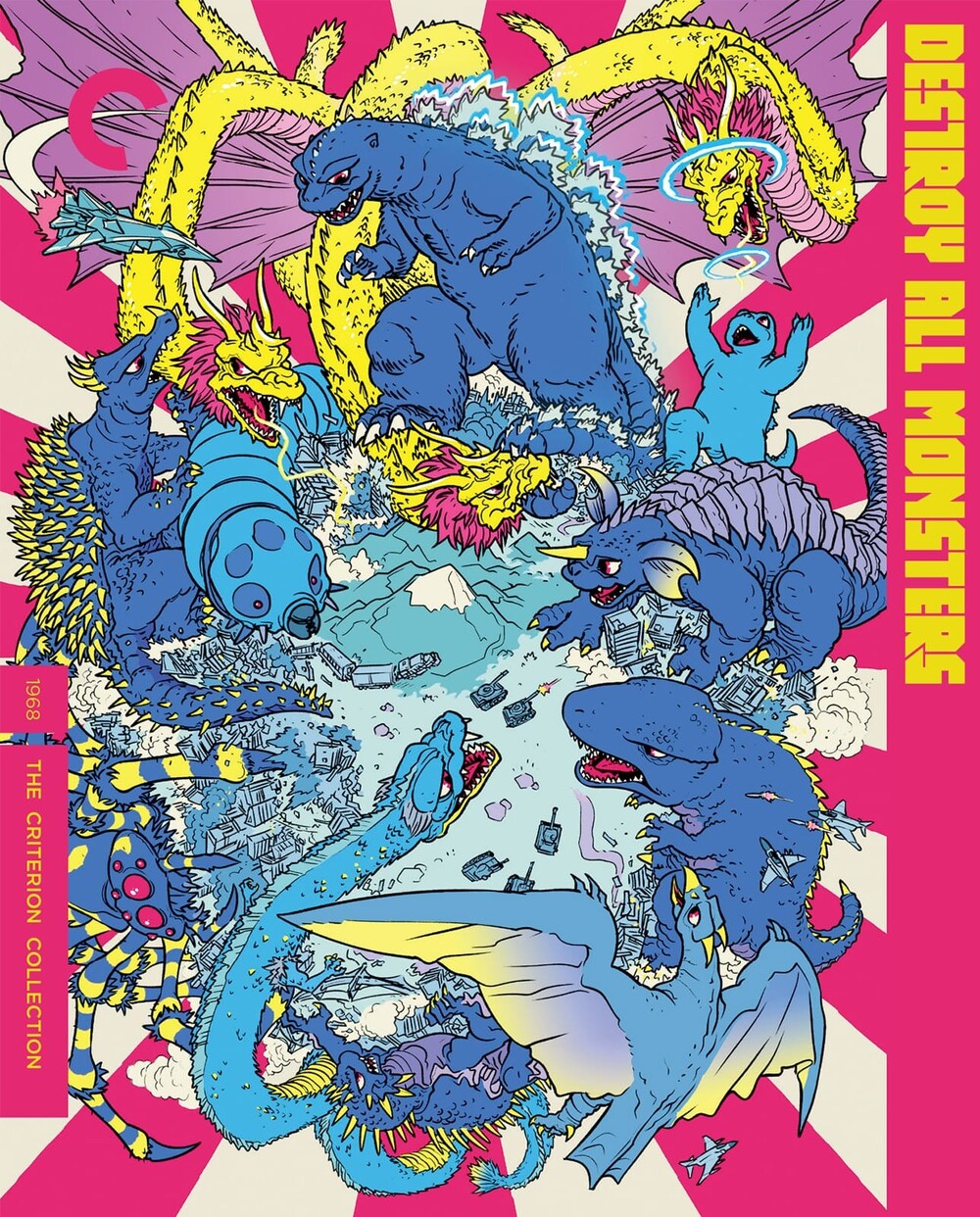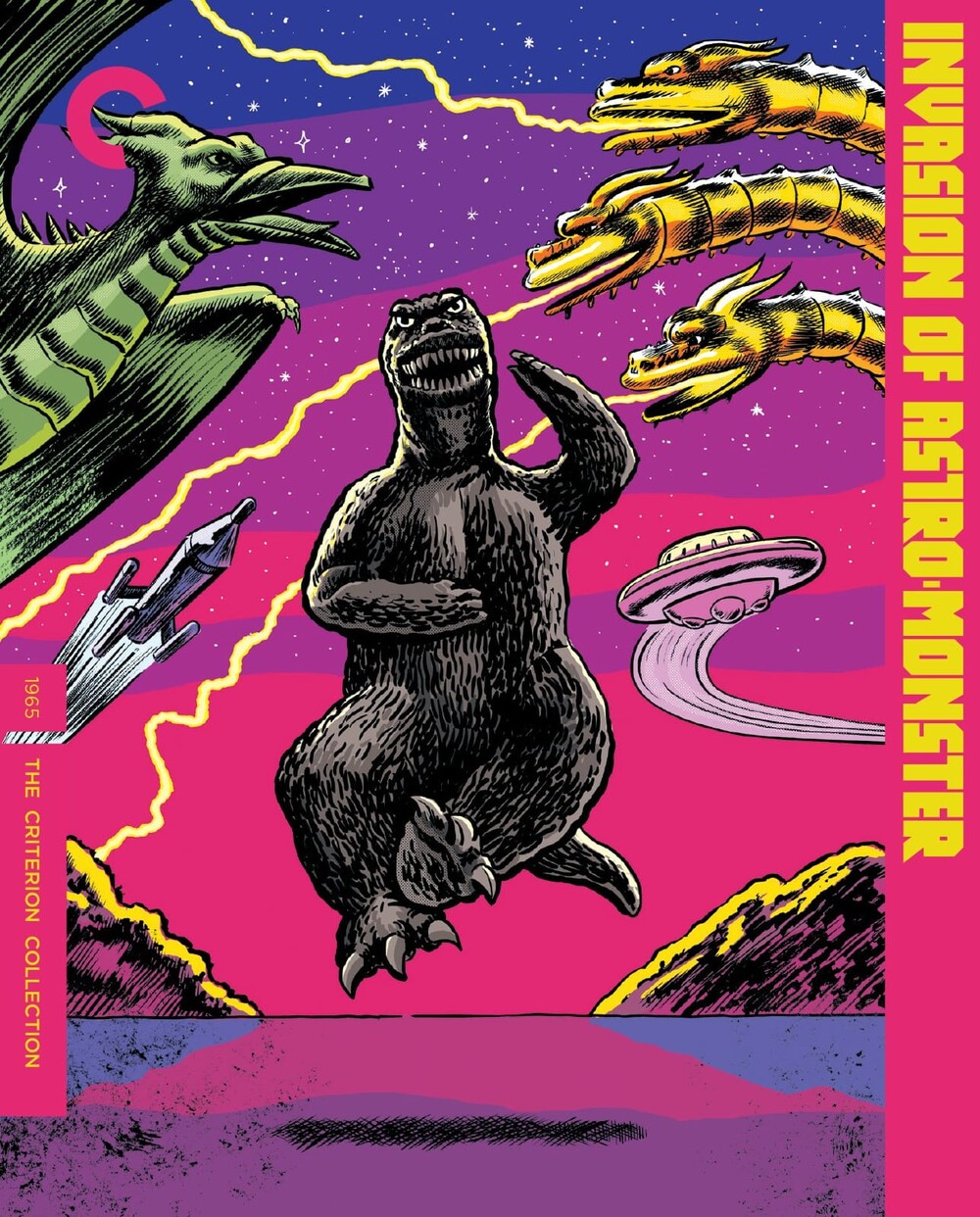-
Par kluseba le 29 Janvier 2020 à 16:32

Destroy All Monsters is the ninth entry in the Godzilla franchise and marks the return of original director Honda Ishiro. After two family-friendly predecessors, this movie goes back to the science-fiction style of Invasion of Astro-Monster three years earlier. The plot deals with female aliens taking control of numerous monsters that then proceed to attack big cities around the world. Some brave Japanese scientists and astronauts manage to destroy the lunar base of the aliens and free the monsters. The finale is a gigantic battle between earthly monsters and space monster King Ghidorah that turns out to be the aliens' hidden weapon and last resort.
This movie is a welcome change after the two predecessors that tried to attract younger audiences. Destroy All Monsters fetaures epic, impressive and intense fight scenes involving a multitude of monsters. The villains are resilient, pitiless and clever. The settings are more diversified than ever before including monster mayhem in Beijing, London, Moscow, New York City, Paris and Tokyo. The science-fiction elements have been increased and include stylish aliens, futuristic outposts and cool spaceships. The movie's pace is nearly frantic and this film never gets boring.
There are only two minor elements to criticize. The new monsters Gorosaurus and Manga aren't properly introduced and rather unspectacular as well. This is also the first movie that features use of stock footage from previous films which makes it look rather cheap.
Despite those minor flaws, Destroy All Monsters is one of the most eventful entries in the franchise and should please fans of old date and younger audiences alike. The overwhelming science-fiction action rampage is particularly entertaining as well. Many fans of the franchise consider this movie a final highlight of the Showa Era movies. While some later experimental movies are certainly underrated, this film here exemplifies everything that made the franchise so popular throughout the sixties with its villainous aliens, epic battles and diversified monsters. The movie has aged rather well and is still more impressive to watch than most contemporary Hollywood monster and superhero flicks.
-
Par kluseba le 28 Janvier 2020 à 17:18

Filmed in Guam and directed by Fukuda Jun, Son of Godzilla is another family-friendly adventure film in the franchise that will appeal to younger audiences but disappoint most fans of old date. The story revolves around a group of scientists who are trying to develop a sophisticated weather-controling system on a remote island. The isolation and lack of success puts a lot of pressure on the team and things don't get better when a nosey reporter parachutes himself onto the island to write a story about them. After a failed experiment, animals on the island grow to enormous sizes. Furthermore, an egg is discovered after a storm. It hatches and reveals Godzilla's son. His father soon comes to protect his infant from the gigantic animals. The scientists, the reporter and a mysterious woman living in a cave get caught in between the fights.
On the positive side, this is a good movie to introduce young children to the Godzilla franchise. The locations in Guam look exotic. The numerous gigantic animals look stunning. The premise of weather-controling systems adds a scientific note to the film. The fights between the numerous monsters are entertaining.
However, the story itself is quite shallow and lacks depth. The characters are mostly uninteresting and seem to be inspired by second-rate adventure films. The main issue is however Godzilla's son called Minilla whose features are supposed to look cute but turn out to be ugly. The monster's behaviour is similar to that of an human child. It crawls around, cries a lot and fails to develop any impressive skills yet. Godzilla tries to act like an instructing father which further antropomorphizes the once-feared king of monsters. The birth of Minilla is never truly explained either and one has to wonder whether it's really Godzilla's son or perhaps an adopted monster of unknown origin.
Son of Godzilla has a few creative ideas, is a logical continuation of the preceding movies and certainly very entertaining for younger audiences. However, a childish baby monster and the king of monsters acting like a father figure are certainly not what Honda Ishiro imagined when he directed the franchise's first movie thirteen years earlier. Son of Godzilla is an acquired taste but ultimately good for what it is.
-
Par kluseba le 27 Janvier 2020 à 17:18

With the seventh entry in the franchise, entitled Ebirah, Horror of the Deep, the Godzilla movie series definitely enters adventure film territory. The beloved lizard also moves away from being considered a dangerous antagonist and becomes an earthly protector and sympathetic anthropomorphized protagonist. These changes appeal to younger and wider audiences while adults and fans of old date might dislike those changes. One has to understand that those modifications managed to keep the series successful enough to keep it going until the mid-seventies. Director Fukuda Jun replaced veteran Honda Ishiro here and his movies are overall rather family-friendly. Ebirah, Horror of the Deep is a first step into more light-hearted territories.
This particular movie succeeds because old and new elements are still quite balanced here. The titular gigantic lobster is an impressive monster that constantly wreaks havoc. The terrorist organization that kidnaps indigenous people for forced labour is also quite grizly. Godzilla annihilates a giant condor, destroys a squadron of fighter jets and fights Ebirah in violent fashion.
On the other side, Godzilla is awakened to help the human heroes and wreaks havoc among the terrorists. Gigantic moth Mothra comes to save indigenous people and is represented as a symbol of hope, love and even motherhood. The human heroes in this film are particularly sympathetic, creative and brave while strong and convincing antagonists are missing this time.
One of the movie's strengths is its location on an isolated island. The movie explores rocky mountains, hidden caves and stony beaches that contrast the modern facilities of the terrorists. This is certainly a contrast to previous movies that mostly took place in crowded cities or in space. If you ignore the monsters, this movie could have been an adventurous spy flick in the key of the James Bond franchise.
In the end, the seventh entry in the franchise introduces some fresh changes and is entertaining from start to finish. This movie might appeal to children and teenagers in particular. The film is however missing the philosophical, mysterious and dystopian undertone of its predecessors. Ebirah, Horror of the Deep foreshadows the changes the franchise would go through in the next decade.
-
Par kluseba le 27 Janvier 2020 à 06:32

Invasion of Astro-Monster is the most creative, diversified and entertaining entry in the franchise in the sixties along with cult movie Mothra vs. Godzilla. The story revolves around a Japanese and an American astronaut who encounter extraterrestrials on a mysterious planet. They are terrorized by space monster King Ghidorah and ask mankind to borrow Rodan and Godzilla to protect them. In return, they want to give a miracle cure for cancer and offer the possibility to share their advanced scientific skills with mankind. However, the extraterrestrials aren't as diplomatic as they pretend to be and plan on using the three monsters to conquer the Earth. With the help of an extraterrestrial spy who falls in love with the American protagonist, the two astronauts try to find a scientific way to beat the clever aliens.
This sixth movie in the franchise is the first one with dominant science-fiction elements. The epic journey through space is fascinating to watch, the alien laboratories look truly creative and even the visual special effects of alien technology are rather ambitious for their era.
The two protagonists have great chemistry. The intelligent and careful Japanese astronaut and the more emotional and frank American astronaut complement each other perfectly. The alien spy who falls in love with the American astronaut after initially tricking him is an idea that goes back to the origins of Greek dramas and tragedies.
The story comes around with many ideas, turns and twists that make for a truly entertaining plot. It keeps viewers on the edge of their seats from start to finish. Some story elements might be predictable here and there but they are executed with so much energy, passion and wit that it barely matters.
There aren't too many lengthy fight sequences between the three legendary monsters as the movie rather focuses on science-fiction stylistics, creative plot twists and intriguing characters. The few confrontations between the three monsters are however executed with much action, drama and special effects. This is a science-fiction movie in first place and only a monster movie in second position.
In the end, Invasion of Astro-Monster is a highly entertaining science-fiction roller coaster ride that can compete with Hollywood cinema of the same era. The creative special effects, quirky plot and sympathetic characters have stood the test of time. This is also one of the few entries in the franchise when the two protagonists come from two completely different countries and cultures. Nick Adams is perfectly integrated into the cast and delivers one of the strongest acting performances in any Showa Era Godzilla movie. His untimely death was a huge loss but his legacy will forever shine in this masterpiece.
-
Par kluseba le 24 Janvier 2020 à 17:27

This fifth entry in the Godzilla franchise introduces the giant lizard's most impressive opponent ever. Ghidorah, the Three-Headed Monster doesn't only convince with intense fights involving Godzilla, King Ghidorah, Rodan and Mothra but also with a quirky plot involving a princess possessed by Venusians and tracked down by her uncle who attempts to assassinate her. Released only eight months after Mothra versus Godzilla, this movie surprisingly convinces with great cinematography and special effects for its time. It's impressive how quickly those involved in the project managed to pull off a high-quality kaiju eiga.
While the plot is fairly unrealistic, even by science-fiction movie standards, this movie is entertaining from start to finish. The diversified set of characters is quite dynamic, quirky and sympathetic. The three story lines involving scientists examining a meteor, a princess escaping her own assassination and four monsters fighting on an earthly battlefield are quite overwhelming but fusion well in the movie's second half and keep viewers on the edges of their seats. This film is as much an adventure flick and a thriller as it is a science-fiction movie. It might be the most diversified movie in the entire franchise.
To keep it short, Ghidorah, the Three-Headed Monster is one of the most creative, diversified and quirky movies in the franchise that still entertains from start to finish after all these years. The introduction of the franchise's scariest villain is another reason why this movie is rightfully considered a classic. Ignore the overwhelming plot elements and at times frantic pace in the first half and enjoy all the action, drama and effects that lead to a wholly satisfactory second half and explosive conclusion.
 Suivre le flux RSS des articles de cette rubrique
Suivre le flux RSS des articles de cette rubrique













